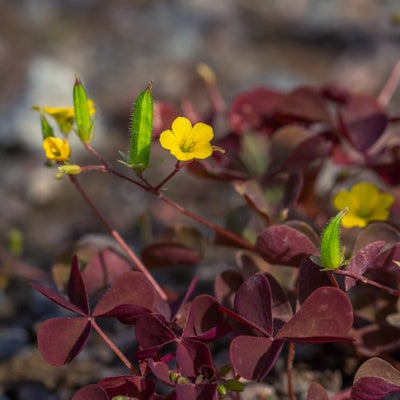
Quick facts
Oxalis is commonly known as sorrel; other common names include false shamrock, sour grass, sour clover and sleeping beauty
Oxalis corniculata, O. debilis and O. latifolia are perennial, UK non-native species
Oxalis can spread by seed, creeping stems or bulbils; methods differ according to species
If you need to control oxalis, non-chemical methods are effective
What does oxalis look like?
There are hundreds of species of oxalis, but this page focuses on three that are sometimes problematic to UK gardeners. While each type has trifoliate leaves (with three leaflets) and summer flowers, they spread in slightly different ways, so it is useful to identify which one you have if you wish to control it.
Oxalis corniculata
O. corniculata, commonly known as yellow-sorrel, procumbent yellow-sorrel or creeping wood-sorrel, is a low-growing with branched, creeping stems. Its small, clover-like leaves vary in colour from mid-green to dark purple. Small, yellow, five-petalled flowers produced from spring to early autumn are followed by upright seedpods. O. corniculata grows to about 10cm (4in) tall and its low rooting stems can spread 50cm (20in).

Oxalis debilis
O. debilis (syn. O. corymbosa) is a perennial, bulbous plant, commonly known as large-flowered pink-sorrel or pink wood-sorrel. Green leaves with three heart-shaped leaflets grow on stalks about 20cm (8in) tall. Pink or pinkish-mauve flowers appear in summer and early autumn on flower stalks slightly taller than the leaves. Individual plants form clumps up to 30cm (12in) wide, growing from a scaly bulb, with bulblets, swollen succulent roots and finer fibrous roots.

Oxalis latifolia
O. latifolia is a perennial, bulbous plant, commonly known as garden pink-sorrel, broadleaf wood-sorrel or fishtail oxalis. It is like O. debilis in size and flower colour but has a less rounded leaf shape (the leaflets often resemble fish tails). Underground, it forms swollen succulent roots, scaly and, unlike O. debilis, bulblets form at the end of (horizontal underground stems).

If you are unsure which oxalis you have growing in your garden and would like to be sure, RHS members can use the RHS Gardening Advice service to submit photographs for identification.
Is oxalis a weed?
Many species of oxalis are highly valued as garden or houseplants. Oxalis acetosella (wood-sorrel), for example, is a UK species that makes a great addition to shady, woodland-edge borders. O. tetraphylla 'Iron Cross' and O. versicolor make eye-catching alpine plants, while indoors, O. triangularis and O. debilis ‘Aureoreticulata’ make attractive and easy to grow houseplants.
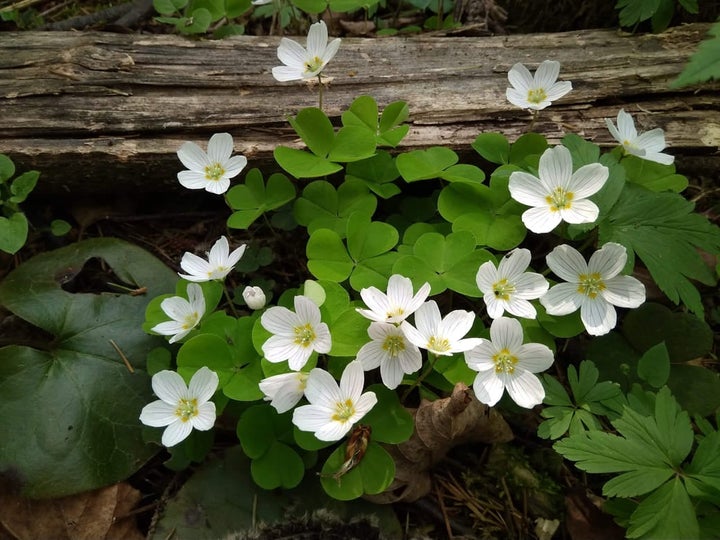
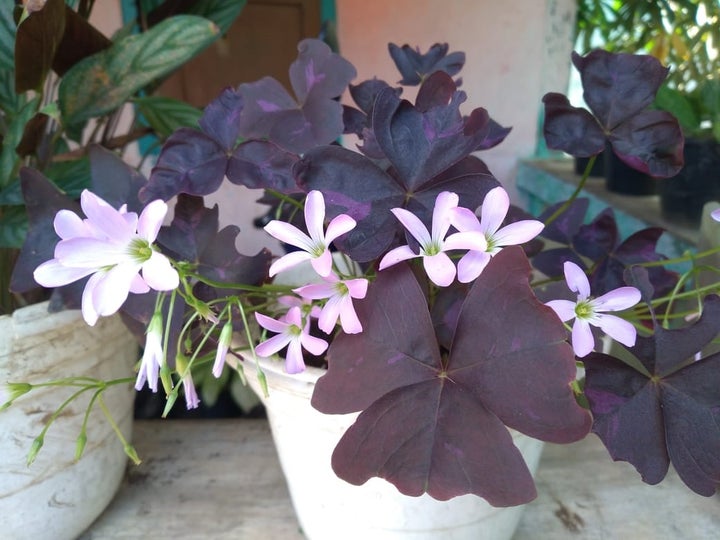

O. corniculata, O. debilis and O. latifolia also have some great qualities. They have been used and valued as medicinal and food plants for centuries – this may partly explain how they have spread far beyond their native ranges. Their leaves provide food and shelter for ground-active invertebrates, such as beetles and caterpillars, and O. debilis is a food plant for bright-line brown-eye moths.
Although useful plants, with bright, cheery flowers, many gardeners consider O. corniculata, O. debilis and O. latifolia as weeds, due to their persistence and ability to multiply quickly.
O. corniculata is so low-growing that it rarely affects other plants, although it is problematic in seedbeds. The taller, clump forming growth of O. debilis and O. latifolia can, however, smother small or emerging plants.
What is a weed?
The term ‘weed’ describes a plant that is growing where it isn’t wanted. Weeds usually thrive in average garden conditions, reproducing and spreading easily. It is up to you to decide what you call a weed and what you choose to retain or remove.
Frequently asked questions about controlling oxalis
Here are our answers to your most common questions about dealing with oxalis:
How invasive is oxalis?
O. corniculata, O. debilis and O. latifolia can multiply and spread quickly, using different methods:
O. corniculata forms low carpets of growth with its rooting stems. However, it mainly spreads by seed. Plants produce large quantities of seed, and when ripe, in late summer and autumn, they are ejected at speed from the upright seedpods, effectively scattering them away from the parent plant.
O. debilis rarely produces seed in UK gardens, but the tiny bulbils, which are attached to the parent plant, are easily dislodged and spread when digging.
O. latifolia usually spreads by bulbils but it can also spread by seed. Bulbils form on the end of , up to 10cm (4in) away from the base of the main bulb.
The bulbils of O. debilis and O. latifolia are easily detached from plants and inadvertently spread by gardeners moving soil, or on tools and boots. Being mindful of where you dig (and if you need to dig at all) helps to reduce their spread. Bulbils range in size, with the smallest being difficult to see and pick out of the soil, and they can remain viable in the soil for several years. Disturbing or cutting down plants often results in the production of more bulbils.
The good news is that O. debilis and O. latifolia prefer open habitats and don’t tend to grow well in lawns or among other plants. Planting densely and filling gaps in borders is therefore an effective way to limit their spread.
Do I need to get rid of oxalis?
No – allowing oxalis to grow in your garden helps to increase its and gives you the chance to enjoy the attractive flowers.
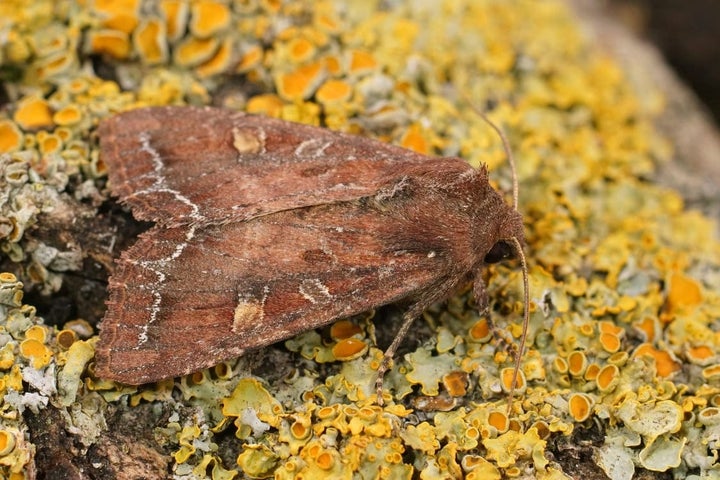
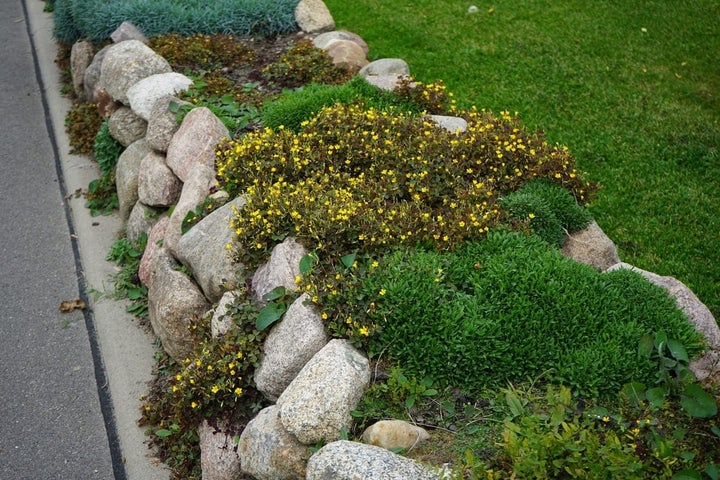
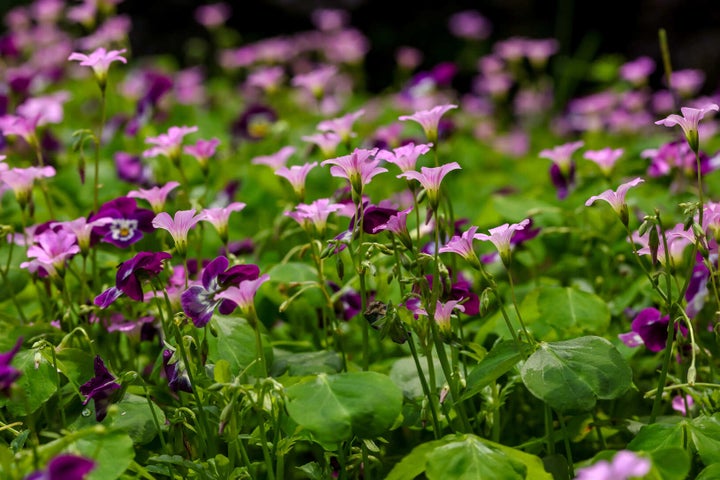
O. corniculata is generally harmless when growing among or in paving. However, it seeds prolifically, so you may choose to prevent it self-seeding or remove it from some areas, such as seedbeds and fine lawns.
O. debilis growing under or among large established plants is not likely to be troublesome if left undisturbed. However, you may choose to control the growth and spread of O. debilis and O. latifolia into areas where they could outcompete and smother smaller or less vigorous plants.
Did you know?
The genus name Oxalis is derived from the Greek word oxus, meaning sour. This is due to the sour, sharp and tangy taste of oxalis leaves. Leaves can be eaten raw or cooked, but it is recommended to only eat small amounts to limit intake of oxalic acid.
What is the easiest way to kill oxalis?
If you have oxalis growing where it is not wanted, there are ways to control it.
Oxalis corniculata:
- – snip off the spent flowers of O. corniculata to prevent it spreading by seed. This is a fiddly task, so is only feasible when few plants are present.
- Hoe off – hoe on a warm, dry, or windy day, so the exposed roots of seedlings dry out quickly
- Fork or dig out plants – use a hand fork or trowel to dig out the main of O. corniculata at the centre of the plant, ideally before seed is produced. Hand tools designed for deep-rooted weeds, often sold as ‘dandelion weeders’, are useful for targeting taproots and limiting soil disturbance. Remove small, recently rooted sections along creeping stems with a hand fork.
- Adjust growing conditions – if O. corniculata is a problem in your lawn, follow good spring/summer and autumn maintenance regimes to boost grass vigour and fill gaps.
- Rake before mowing – rake over areas in a lawn to lift low-lying stems of O. corniculata, so your mower can cut, collect and remove them. This will prevent self-seeding, reduce their spread and help weaken individual plants.
Oxalis debilis and Oxalis latifolia:
- Fork or dig out plants - use a hand fork, trowel or border spade to lift out the fleshy roots, and bulbils, taking time and care not to dislodge and spread the bulbils. This is best done in spring when tiny, developing bulbils are more firmly attached to the parent plant. Monitor the area for regrowth from any missed bulbils, removing as seen.
- Avoid disturbing the soil – new plants of O. debilis and O. latifolia grow from tiny, easily dispersed bulbils, so avoid unnecessary digging or rotavating in areas where they are growing.
- Smother plants – where oxalis is widespread, cover the ground with a layer of compostable material, such as cardboard, and then a layer about 20cm (8in) thick of organic matter, such as or wood chips. Alternatively, use a heavy grade matting. This will block light and prevent growth, causing the root system to die. Keep soil covered for a few years, topping up the mulch layer if necessary, to ensure this method is effective.
Top Tip
Don’t add roots, bulbs, bulbils or seed of oxalis to your home compost bin, as it is unlikely to reach high enough temperatures to kill them. Instead, put them in your council green waste recycling bin or take them to your local recycling site.
Should I use weedkiller?
Weedkillers available to home gardeners aren’t effective at controlling oxalis. As non-chemical control methods are effective, even if time-consuming, they are your best option.
For more information, see our page on Weeds: non-chemical controls.












